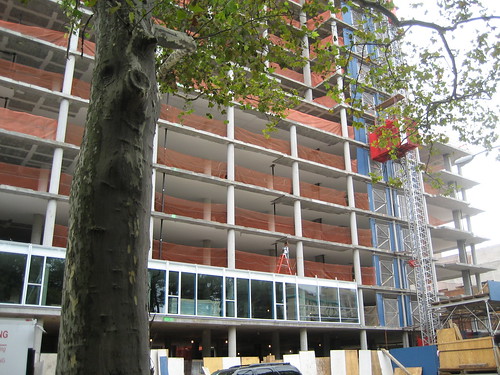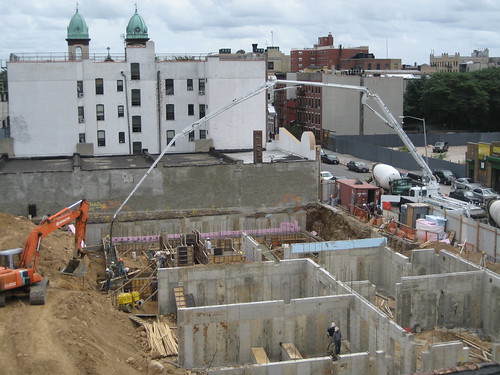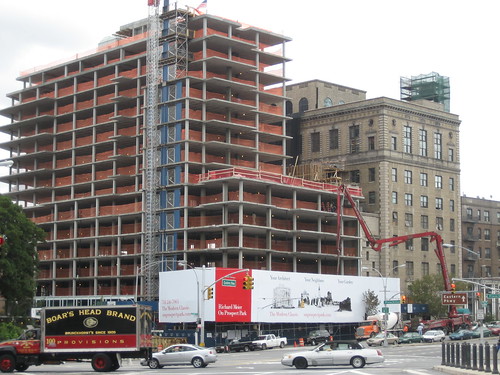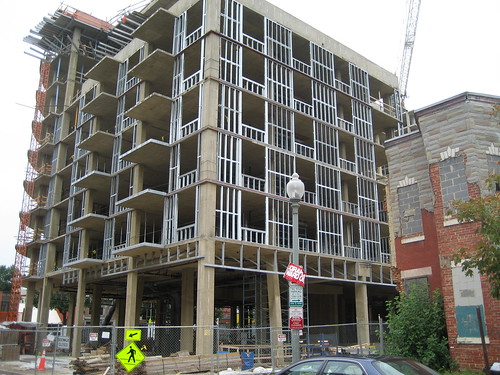concrete jungle
There are many theories regarding the cause of the construction boom taking place in New York and other American cities right now. Lost in the debate over social change and gentrification, however, is the simple fact that advances in concrete technology are making reinforced concrete construction cheaper than it's ever been before.

Concrete has made huge impacts on the built environment before. The biggest difference between ancient Greek and Roman construction, for example, was that the Romans used concrete to bond their masonry -- a slushy mixture of gravel, water and chemicals that cured as hard as stone. Without concrete, we wouldn't have the Pantheon or the Colosseum.
Modernity's big contribution has been the addition of rebar: steel bars embedded in the liquid as it cures that dramatically improve the material's tensile strength. Reinforced concrete has been around since the 1850s, but it wasn't used very much for residential construction until Frank Lloyd Wright's cantilevered structures, which are only possible with steel rebar, became popular in the mid-20th century.

While the construction materials used today are basically the same as those from the 1950s, there are several recent technological advances like pre-stressing which have changed how reinforced concrete is used. In New York, the most relevant of these innovations is the introduction of the concrete pumping truck.
These awesome machines are basically fire engines that pump concrete instead of water. They can either pump concrete across a long distance or up to the top of a tall structure without the use of a crane. In addition to reducing the requirements for equipment and labor, they also permit faster construction, reducing the carrying costs for a developer for a work-in-progress.

I'm cautiously optimistic about Richard Meier's new apartment building on Grand Army Plaza, which is being built with a concrete pumping truck. (The 'Putzmeister', I was delighted to learn upon closer inspection.) Though construction on this structure also used a crane, I doubt that this project would have had the budget for a starchitect like Meier without the use of pumping trucks to reduce costs.
One potential pitfall of this new technology, however, is that it can make it cheaper to build a new structure than to rehab an old one.
 New development along Washington DC's U Street Corridor.
New development along Washington DC's U Street Corridor.
One principle of Smart Growth is to reuse existing buildings as much as possible for sustainable development. With the economics of construction as they are now, it's easy to see why big developers have yet to fully sign on to this concept. Hopefully new construction technologies can reduce the cost of rehabilitating old structures as well in the near future.
In the meantime, I'll still get a kick out of watching the pumping truck that works all day behind my apartment.

Concrete has made huge impacts on the built environment before. The biggest difference between ancient Greek and Roman construction, for example, was that the Romans used concrete to bond their masonry -- a slushy mixture of gravel, water and chemicals that cured as hard as stone. Without concrete, we wouldn't have the Pantheon or the Colosseum.
Modernity's big contribution has been the addition of rebar: steel bars embedded in the liquid as it cures that dramatically improve the material's tensile strength. Reinforced concrete has been around since the 1850s, but it wasn't used very much for residential construction until Frank Lloyd Wright's cantilevered structures, which are only possible with steel rebar, became popular in the mid-20th century.

While the construction materials used today are basically the same as those from the 1950s, there are several recent technological advances like pre-stressing which have changed how reinforced concrete is used. In New York, the most relevant of these innovations is the introduction of the concrete pumping truck.
These awesome machines are basically fire engines that pump concrete instead of water. They can either pump concrete across a long distance or up to the top of a tall structure without the use of a crane. In addition to reducing the requirements for equipment and labor, they also permit faster construction, reducing the carrying costs for a developer for a work-in-progress.

I'm cautiously optimistic about Richard Meier's new apartment building on Grand Army Plaza, which is being built with a concrete pumping truck. (The 'Putzmeister', I was delighted to learn upon closer inspection.) Though construction on this structure also used a crane, I doubt that this project would have had the budget for a starchitect like Meier without the use of pumping trucks to reduce costs.
One potential pitfall of this new technology, however, is that it can make it cheaper to build a new structure than to rehab an old one.
 New development along Washington DC's U Street Corridor.
New development along Washington DC's U Street Corridor.One principle of Smart Growth is to reuse existing buildings as much as possible for sustainable development. With the economics of construction as they are now, it's easy to see why big developers have yet to fully sign on to this concept. Hopefully new construction technologies can reduce the cost of rehabilitating old structures as well in the near future.
In the meantime, I'll still get a kick out of watching the pumping truck that works all day behind my apartment.

2 comments:
Just a thought on reinforced concrete for multi-story buildings: The cost of steel right now is astronomical, making it an easy choice for a repetitive buidling by the architect.
Also, floor to floor heights with concrete can be significantly less, getting more square footage in less overall height. I like Richard Meier's work, but he's a slave to cost like all of us architects out there.
Yeah, those concrete pumps are a great idea in my opinion, and the booms are more accurate than I expected. I wonder why aren't they too widely used outside of U.S. though.
Post a Comment